Inside the SKTCHD/Off Panel Offices and Processes
If there’s one consistent topic that comes up from subscribers and listeners that isn’t strictly related to thoughts about comics, it’s questions about what I do and how I do it. That’s not to say what I do is some sort of great mystery. Most of my approach is extremely similar to how everyone would do this kind of thing: sit at a keyboard and then type until you’re done typing, or speak into a microphone in a conversational fashion. There are only so many ways to reinvent those wheels.
But I’ve also had people ask me things like, “What’s your podcasting studio like?” or, more recently, “What’s your interviewing ethos?” Those are extremely legitimate, reasonable, thoughtful questions to ask a professional who does the sort of things I do. However, because I am more “fortunate urchin” than “actual professional,” my response is perhaps best depicted in my second favorite Nick Young gif, as shown below, followed by eternal silence.
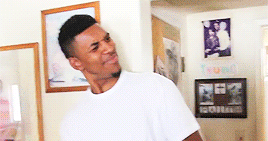
For that reason, I’ve had designs on providing subscribers and patrons an inside look at everything I do, from answers to some of the questions that are asked the most to a look at my office. I’ll even take you inside my head when it comes to the little fandom things that make us each unique flowers rather than homogenous comic readers. That’s what we’ll be doing today, as I answer both real and theoretical questions about my processes, and in a way that’s typically exhaustive and exhausting. It’ll also be fun — I hope. The goal is to cover all the bases here, but if you have any additional questions, let me know in the comments!
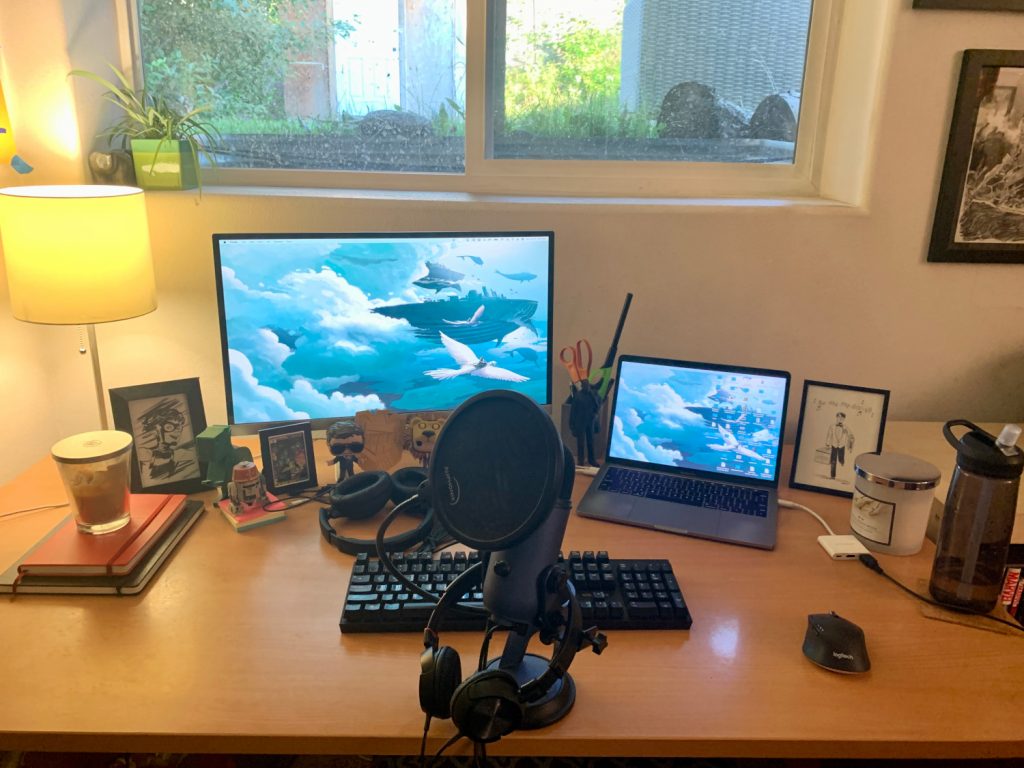
What does your podcasting “studio” and workspace like?
I listened to a podcast that discussed the best comic podcasts a while back, one that Off Panel was fortunate enough to show up on. When the hosts talked about the show, one commented about how good it sounds, openly wondering about what my studio looks like to produce that quality. I loved hearing it, even if it made me grimace as I looked around at my actual setup. This is where I dispel with any useful mysteries about my studio. It isn’t a studio at all. It’s just the desk I work at for my day job and write at for SKTCHD. (Excluding the times when I’m writing a coffee shop or something) (As I am right now)
The only real difference between my desk at regular times and during a podcast recording is I add a microphone. More specifically, about two minutes before I record an episode of the show, I move my keyboard forward about eight inches, frantically grab my microphone – which typically resides on the floor to the left of my desk – place it on my desk, plug it into my computer, and then get going. As proof of that, here’s a photo of my desk during non-podcasting times.
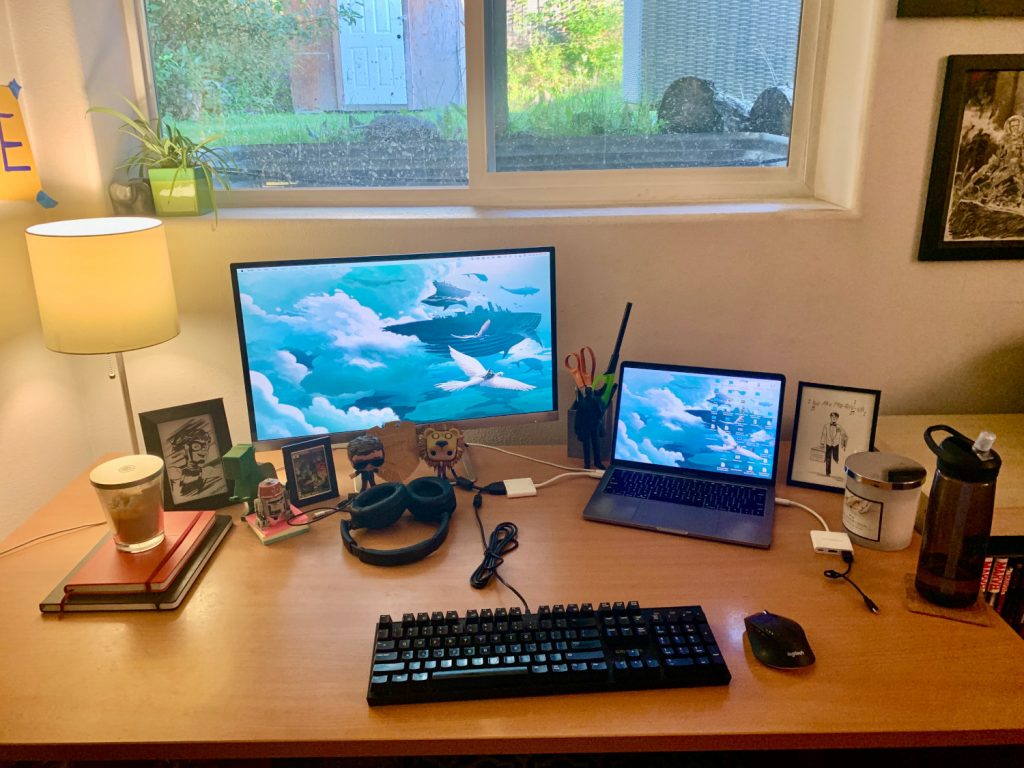
Not much of a difference, right?
While I’ve considered getting one of those fancy microphone arm things that swivel out if and when I want to record a show — or even a webcam of a higher quality rather than the onboard Macbook Pro camera I use — every time I do, I get preemptively exhausted and decide against it. I’m rather fortunate, though. I have a home office for my work and for my endlessly swelling comic collection. While just plugging a USB microphone into a computer and hoping for the best wouldn’t work for most, having an office that’s the right size with a door on it ensures a consistent audio quality. It’s not a professional setup, but apparently it works!
In terms of the gear side of things, it’s really just a Blue Yeti microphone, which is completely plug and play with my Macbook Pro. The only wrinkle is a pop filter. I didn’t even buy that. Someone gifted me it because they suggested it would help. It did! Somehow, that all combines to make high quality audio.
My non-audio setup includes two screens, with one being a pretty vanilla (but sizable) monitor and the other being my Macbook. I use a mechanical keyboard that is pleasantly loud and tactile, unless you’re one of my cats and you’re sleeping on my lap, in which case it’s a living nightmare. There’s also a pair of Sony WH-1000XM4 headphones, which are incredible, but are so effective at noise-canceling that someone could rob my home while I’m wearing them and I wouldn’t even realize it.
Besides that, my desk is a mess of randomness. Art on there includes – left to right – an Impulse by Chris Samnee, a framed Marvel Universe Series 2 Fin Fang Foom card drawn by Arthur Adams, and a Max Fischer (from Rushmore) drawn by Dustin Harbin. I also have assorted candles, because I like nice smells and ambiance. Fun fact: I only learned how to properly use those recently thanks to the wonderful cartoonist/candle expert that is Liana Kangas! There’s also a T-Rex on there that dispenses sticky notes, a Chopper Black Series figure my pal John Hendrick (from Big Bang Comics in Dublin) sent me, Burt Macklin and Luna Lovegood Pop figures, a Shaft figure circa Samuel L. Jackson, and a Judge Dredd-style badge that Christopher Sebela 3D printed for me.
What’s your process for recording, editing, and setting up a podcast?
So if I have the most basic setup known to man for podcasting, then how does that result in a quality sounding show? The short answer is…I don’t know! I’ve gotten that compliment for years – along with some useful feedback on ways I could improve it – but the truth is, I had no idea what I was doing when I first started Off Panel. It’s been a process of learning on the fly and reading articles that resulted in a reasonably pleasant sounding show.
That said, I can walk you through my overall process, which might help you better understand the method behind my madness. It all starts with the recording. While many pros use fancy recording equipment and software, I was fortunate to have bought a license to Call Recorder for Skype years ago. This one time expenditure of, I believe, $30 has resulted in crisp, consistent audio quality in my interview files throughout my time recording Off Panel, even though it also curses me to ask my guests to either download Skype and create a user name or attempt to remember their login. My backup for podcast recordings is Zoom, but I’m going to be honest: it sounds a lot worse! I try to stick to Skype as much as possible. My greatest nightmare is the day in which the company that created Call Recorder for Skype stops updating the software. That briefly appeared to be the case a couple years back, but they changed their mind and updated it anyways. Crisis averted…for now!
Once I record the interviews, I go one of two directions. One is I send the files – splitting myself and my guest(s) into individual recordings, so it’s at least two files – to podcast editing extraordinaire Deanna Chapman for audio editing and leveling. That’s what I’ve been doing as of late. Deanna is much, much better at this than me. The other is I edit it myself in GarageBand before running it through a program called Auphonic for auto leveling. Even when Deanna edits it, I always do a pass myself because I am a fussy baby and want to take notes on discussion topics as I listen. My side of the editing process takes around the length of the episode, in total. I also rerecord significant portions of my outro each episode, because I am a loon and a perfectionist. Once I’m done with that, I’ll output an mp3 for posting purposes.
From there, I write up my post for the podcast, create a header for the episode, and then go to my podcast host – LibSyn – to upload it into their system. LibSyn was the clear choice in my mind when I started the podcast in 2015, but I’ve gotten the impression there are better hosts out there today. And yet, I am lazy and overburdened – a deadly combo – so I never look at other options. Someday! The final piece is setting up the post on SKTCHD, which is already mostly done by this point, and getting the episode up on Patreon so everyone gets early access. All of that mysteriously results in a nice sounding podcast.
Success, I guess!
You mentioned your office. What’s that look like?
Like a place where I’ll eventually get crushed to death by towers of comics?
Here’s a look:
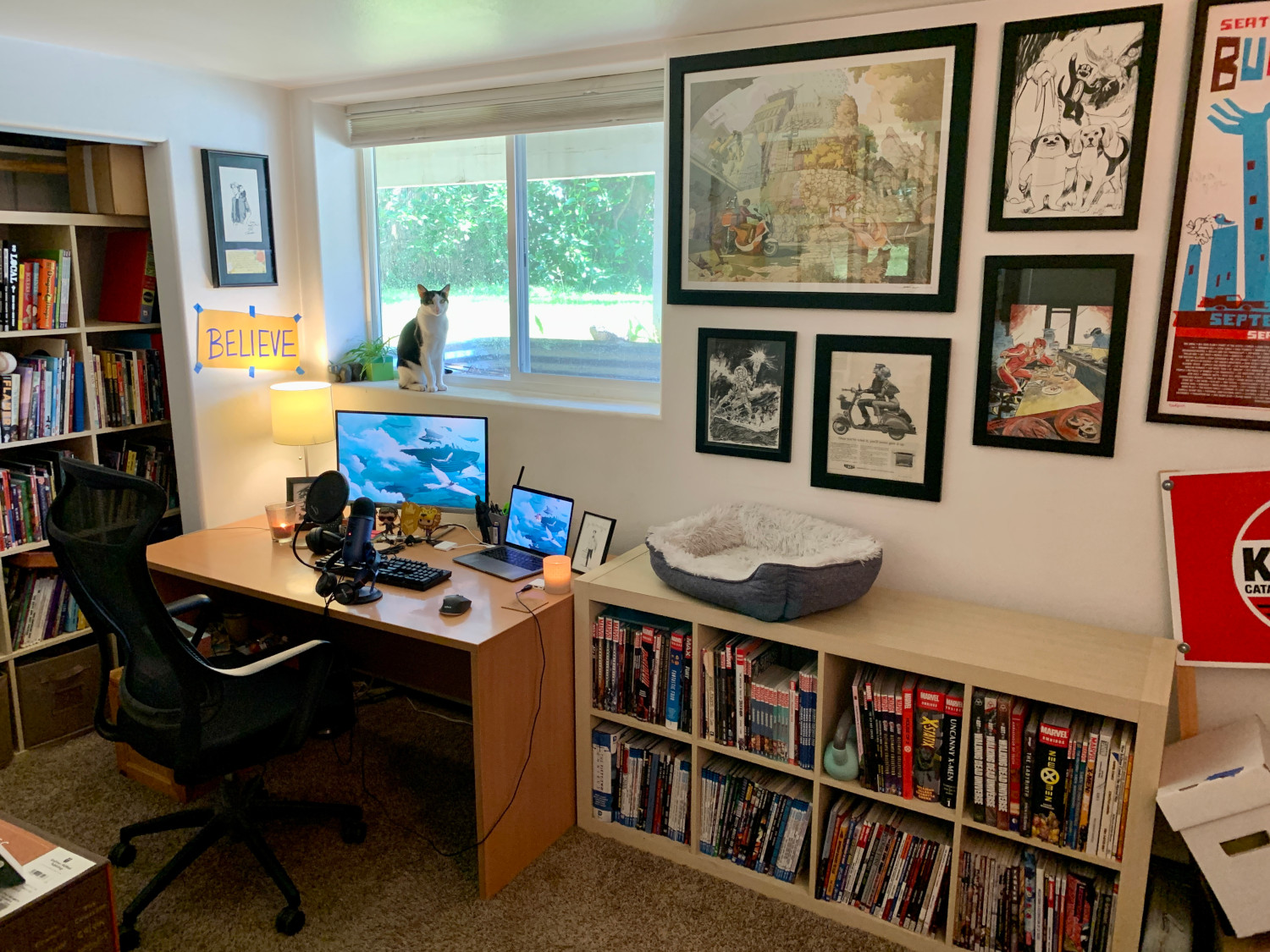
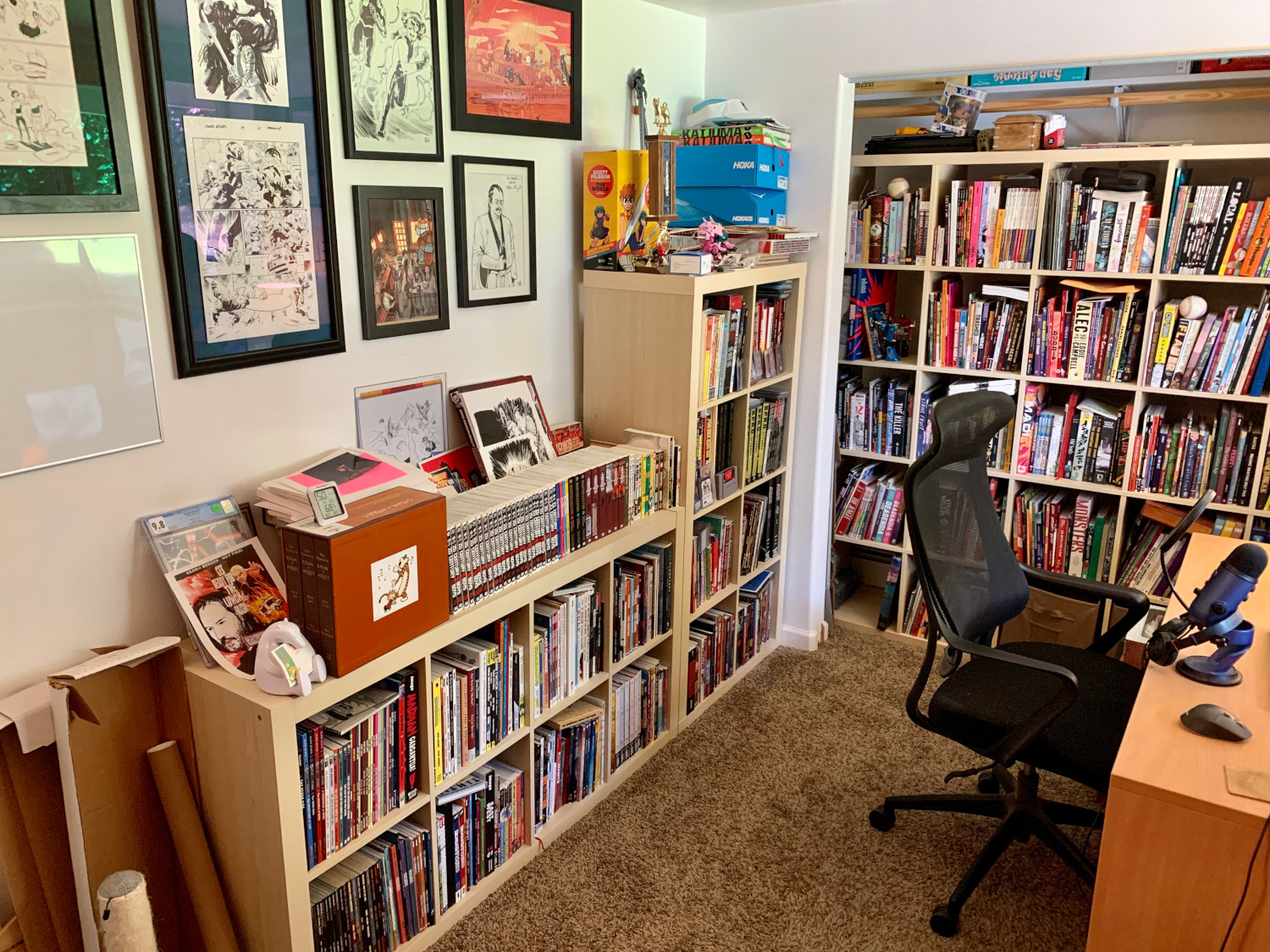
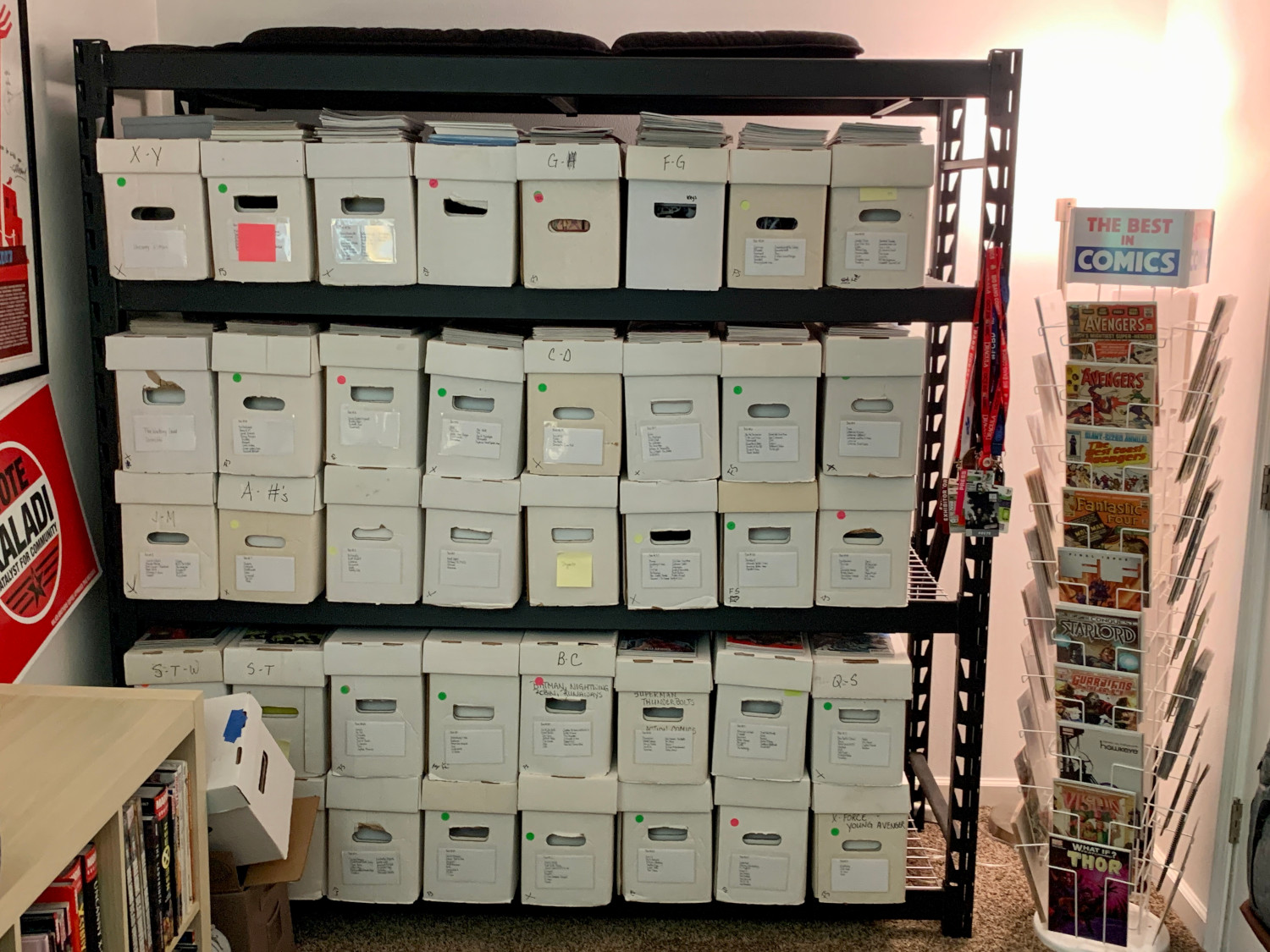
I know what you’re thinking: David has too many comics. I agree with you. It’s absurd. And yet, here I am, still buying comics each Wednesday and getting new trades and graphic novels. There’s a reason I have a comic book garage sale each summer. The bulk of what’s in those long boxes was actually amassed in my youth, when I was…let’s say, less considerate about my approach to acquiring comics. It was mostly either a) is this a comic, if so, I would like to get it or b) does this comic have Wolverine in it, and if yes, I would like to get it, which was complicated by the fact Wolverine was in all the comics in the 1990s. These often came in lots, because lots and grab bags were cheaper per comic than single issues, in my child brain. That means some good, and a lot of randomness. So, if you’d like any copies of The ‘Nam, I might be able to help you with that.
I should note: there’s a cat in the first picture. That’s Kubo. He’s not always there, but he often is. My cats really like being around me. There are pros and cons to that.
subscribers only.
Learn more about what you get with a subscription
